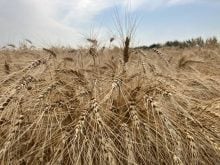BUENOS AIRES (Reuters) – Drought in the heart of Argentina’s Pampas
grains belt is likely to persist through the second half of February,
further reducing yields of soy and corn in the 2017-18 season, climate
experts said on Wednesday.
A three-month dry spell has led the U.S. government and the Buenos Aires
Grains Exchange to cut harvest estimates for Argentina, the world’s top
exporter of soymeal livestock feed and its No. 3 supplier of both corn
and raw soybeans.
The drought has also put upward pressure on international soy and corn
Read Also

Canada offers tariff relief to some steel, aluminum products from U.S., China
Canada offered tariff relief on some steel and aluminum products imported from the U.S. and China, a government document showed, in efforts to help domestic businesses battered by a trade war on two fronts.
“The situation is serious. It would almost take a miracle for the
drought not to continue through the rest of February,” German
Heinzenknecht, a weather specialist with the Applied Climatology
consultancy, told Reuters.
Eduardo Sierra, a climate expert at the grains exchange, also said that
heavy rains were unlikely in the region in the coming weeks.
The Buenos Aires Grains Exchange last week lowered its forecasts for soy
and corn in the 2017-18 season, to 50 million tonnes and 39 million
tonnes, respectively, citing losses caused by the drought.
The U.S. Department of Agriculture also cut its 2017-18 corn crop
estimate to 39 million tonnes from 42 million tonnes. It sees
Argentina’s soybean harvest at 54 million tonnes, down from a previous
“Statistically, March sees more rainfall. But we will be facing a
shortfall after January and February, and as of now, it appears that
situation is unlikely to change,” Heinzenknecht said.














